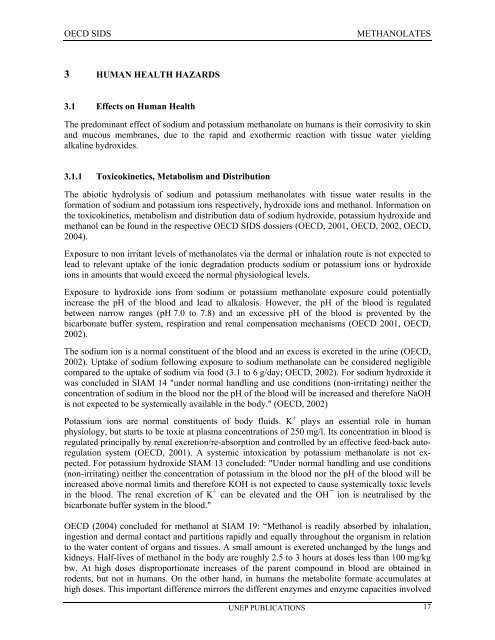Sodium methanolate - ipcs inchem
Sodium methanolate - ipcs inchem
Sodium methanolate - ipcs inchem
Create successful ePaper yourself
Turn your PDF publications into a flip-book with our unique Google optimized e-Paper software.
OECD SIDS<br />
METHANOLATES<br />
3 HUMAN HEALTH HAZARDS<br />
3.1 Effects on Human Health<br />
The predominant effect of sodium and potassium <strong>methanolate</strong> on humans is their corrosivity to skin<br />
and mucous membranes, due to the rapid and exothermic reaction with tissue water yielding<br />
alkaline hydroxides.<br />
3.1.1 Toxicokinetics, Metabolism and Distribution<br />
The abiotic hydrolysis of sodium and potassium <strong>methanolate</strong>s with tissue water results in the<br />
formation of sodium and potassium ions respectively, hydroxide ions and methanol. Information on<br />
the toxicokinetics, metabolism and distribution data of sodium hydroxide, potassium hydroxide and<br />
methanol can be found in the respective OECD SIDS dossiers (OECD, 2001, OECD, 2002, OECD,<br />
2004).<br />
Exposure to non irritant levels of <strong>methanolate</strong>s via the dermal or inhalation route is not expected to<br />
lead to relevant uptake of the ionic degradation products sodium or potassium ions or hydroxide<br />
ions in amounts that would exceed the normal physiological levels.<br />
Exposure to hydroxide ions from sodium or potassium <strong>methanolate</strong> exposure could potentially<br />
increase the pH of the blood and lead to alkalosis. However, the pH of the blood is regulated<br />
between narrow ranges (pH 7.0 to 7.8) and an excessive pH of the blood is prevented by the<br />
bicarbonate buffer system, respiration and renal compensation mechanisms (OECD 2001, OECD,<br />
2002).<br />
The sodium ion is a normal constituent of the blood and an excess is excreted in the urine (OECD,<br />
2002). Uptake of sodium following exposure to sodium <strong>methanolate</strong> can be considered negligible<br />
compared to the uptake of sodium via food (3.1 to 6 g/day; OECD, 2002). For sodium hydroxide it<br />
was concluded in SIAM 14 "under normal handling and use conditions (non-irritating) neither the<br />
concentration of sodium in the blood nor the pH of the blood will be increased and therefore NaOH<br />
is not expected to be systemically available in the body." (OECD, 2002)<br />
Potassium ions are normal constituents of body fluids. K + plays an essential role in human<br />
physiology, but starts to be toxic at plasma concentrations of 250 mg/l. Its concentration in blood is<br />
regulated principally by renal excretion/re-absorption and controlled by an effective feed-back autoregulation<br />
system (OECD, 2001). A systemic intoxication by potassium <strong>methanolate</strong> is not expected.<br />
For potassium hydroxide SIAM 13 concluded: "Under normal handling and use conditions<br />
(non-irritating) neither the concentration of potassium in the blood nor the pH of the blood will be<br />
increased above normal limits and therefore KOH is not expected to cause systemically toxic levels<br />
in the blood. The renal excretion of K + can be elevated and the OH¯ ion is neutralised by the<br />
bicarbonate buffer system in the blood."<br />
OECD (2004) concluded for methanol at SIAM 19: “Methanol is readily absorbed by inhalation,<br />
ingestion and dermal contact and partitions rapidly and equally throughout the organism in relation<br />
to the water content of organs and tissues. A small amount is excreted unchanged by the lungs and<br />
kidneys. Half-lives of methanol in the body are roughly 2.5 to 3 hours at doses less than 100 mg/kg<br />
bw. At high doses disproportionate increases of the parent compound in blood are obtained in<br />
rodents, but not in humans. On the other hand, in humans the metabolite formate accumulates at<br />
high doses. This important difference mirrors the different enzymes and enzyme capacities involved<br />
UNEP PUBLICATIONS 17
















